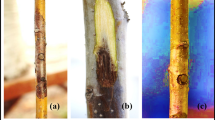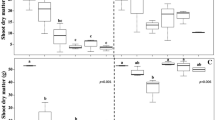Abstract
In addition to pests and diseases, weeds are a major problem in poplar nursery production. The possibilities of herbicide application in juvenile poplar growth were researched, taking into account that weeds are one of the main limiting factors. The following pre-emergence herbicides were tested: acetochlor, S-metolachlor, metribuzin, oxifluorfen, and dimethenamid during two vegetation seasons at two locations, which differed by the soil physico-chemical characteristics. The study results show that the number of weeds on sample plots was significantly reduced by the tested herbicides when compared to control plots. The highest reduction in the number of weeds was achieved using the herbicides acetochlor and metribuzin. However, metribuzin showed a phytotoxic effect on sandy soil. Metribuzin application is recommended only on the soils with higher contents of organic matter, where the phytotoxic effect was absent. Acetochlor, S-metolachlor, oxifluorfen, and dimethenamid were not phytotoxic to poplars and can be used for weed suppression in the production of poplar plants.
Similar content being viewed by others
References
Ahrens HW (1994) Herbicide handbook, 7th edn. Weed Science Society of America, Champaign
Andreasen C, Streibig JC, Haas H (1991) Soil properties affecting the distribution of 37 weed species in Danish fields. Weed Res 31:181–187
Anselmi N, Giorcelli A (1983) Indagini sulle erbe infestanti nei vivai di pioppo di nuovo impianto. Atti. Conv. Le erbe infestanti fattore limitante la produzione agraria, Perugia, pp 109–118
Auskalnis A, Kadzys A (2006) Effect of timing and dosage in herbicide application on weed biomass in spring wheat. Agron Res 4:133–136
Baghestani MA, Zand E, Soufizadeh S, Beheshtian M, Haghighi A, Barjasteh A, Birgani DG, Deihimfard R (2008) Study on the efficacy of weed control in wheat (Triticum aestivum L.) with tank mixtures of grass herbicides with broadleaved herbicides. Crop Prot 27:104–111
Bedmar F, Costa JL, Suero E, Gimenez D (2004) Transport of atrazine and metribuzin in three soils of the humid pampas of Argentina. Weed Technol 18:1–8
Bernasinska J, Duchnowicz P, Koter-Michalak M, Koceva-Chyla A (2013) Effect of safeners on damage of human erythrocytes treated with chloroacetamide herbicides. Environ Toxicol Pharmacol 36(2):368–377
Bolte A, Lof M (2010) Root spatial distribution and biomass partitioning in Quercus robur L. seedlings: the effects of mounding site preparation in oak plantations. Eur J For Res 129:603–612
Buhler DD, Netzer DA, Riemenschneider DE, Hartzler RG (1998) Weed management in short rotation poplar and herbaceous perennial crops grown for biofuel production. Biomass Bioenergy 14(4):385–394
Dixon FL, Clay DV (2004) Effect of herbicides applied pre- and post-emergence on forestry weeds grown from seed. Crop Prot 23:713–721
Duke SO, Lydon J, Becerril JM, Sherman TD, Lehnen LP, Matsumoto H (1991) Protoporphyrinogen oxidase inhibiting herbicides. Weed Sci 39:465–473
Flores-Maya S, Gomez-Arroyo S, Calderon-Segura ME, Villalobos-Pietrini R, Waliszewski SM, Gomez de la Cruz L (2005) Promutagen activation of triazine herbicides metribuzin and ametryn through Vicia faba metabolism inducing sister chromatid exchanges in human lymphocytes in vitro and in V. faba root tip meristems. Toxicol In Vitro 19:243–251
Fortier J, Messier C (2006) Are chemical treatments more sustainable for forest vegetation in the context of the TRIAD? For Chron 82(6):806–818
Geoffroy L, Teisseire H, Couderchet M, Vernet G (2002) Effect of oxyfluorfen and diuron alone and in mixture on antioxidative enzymes of Scenedesmus obliquus. Pestic Biochem Physiol 72:178–185
George BH, Brennan PD (2002) Herbicides are more cost-effective than alternative weed control methods for increasing early growth of Eucalyptus dunnii and Eucalyptus saligna. N For 24:147–163
Gourley M, Vomocil M, Newton M (1990) Forest weeding reduces the effect of deer browsing on Douglas-fir. For Ecol Manag 36:177–185
Gronwald JW (1994) Resistance to PSII inhibiting herbicides. In: Powles SB, Holtum JAM (eds) Herbicide resistance in plants. Lewis Publishers, Boca Raton, pp 27–59
Hansen EA, Netzer DA (1985) Weed control using herbicides in short rotation intensively cultured poplar plantations. Research Paper NC-260. U.S. Department of Agriculture, Forest Service, North Central Forest Experiment Station
Hasanuzzaman M, Ali MH, Alam MM, Akther M, Alam KF (2009) Evaluation of preemergence herbicide and hand weeding on the weed control efficiency and performance of transplanted Aus rice. Am Eurasian J Agron 2(3):138–143
Ivanisevic P, Roncevic S, Orlovic S (1997) Transpiration of poplar rooted cuttings depending on soil textural class, In: Proceedings of the 3rd international conference on the development of forestry and wood science/technology, Belgrade and Mt. Goc, pp 137–144
Jacobs JM, Jacobs NJ, Sherman TD, Duke SO (1991) Effect of diphenyl ether herbicides on oxidation of protoporphyrinogen to protoporphyrin in organellar and plasma membrane enriched fractions of barley. Plant Physiol 97:197–203
Janjic V, Elezovic I (2010) Pesticides in agriculture and forestry of Serbia. The Plant Protection Society of Serbia, Belgrade
Kabba BS, Knight JD, Van Rees KCJ (2007) Growth of hybrid poplar as affected by dandelion and quackgrass competition. Plant Soil 298:203–217
Ludvik J, Zuman P (2000) Adsorption of 1,2,4-triazine pesticides metamitron and metribuzin on lignin. Microchem J 64:15–20
Main CL, Michael AJ, Murdock EC (2007) Weed response and tolerance of enhanced glyphosate-resistant cotton to glyphosate. J Cotton Sci 11:104–109
Majumdar K, Singh N (2007) Effect of soil amendments on sorption and mobility of metribuzin in soils. Chemosphere 66:630–637
Marino PC, Gross KL (1998) Competitive effects of conspecific and herbaceous (weeds) plants on growth and branch architecture of Populus × euramericana cv. Eugenei. Can J For Res 28:359–367
Matthes B, Boger P (2002) Chloroacetamides affect the plasma membrane. Z Nat 57c:843–852
McCarthy N, Bentsen NS, Willoughby I, Balandier P (2011) The state of forest vegetation management in Europe in the 21st century. Eur J For Res 130:7–16
McDonald PM, Fiddler OG (1993) Feasibility of alternatives to herbicides in young conifer plantations in California. Can J For Res 23:2015–2022
Meilan R, Han KH, Ma C, DiFazio SP, Eaton JA, Hoien EA, Stanton BJ, Crockett RP, Taylor ML, James RR, Skinner JS, Jouanin L, Pilate G, Strauss SH (2002) The CP4 transgene provides high levels of tolerance to Roundup® herbicide in field-grown hybrid poplars. Can J For Res 32:967–976
Mengistu LW, Mueller-Warrant GW, Liston A, Barker RE (2000) psb Mutation (valine219 to isoleucine) in Poa annua resistant to metribuzin and duron. Pest Manag Sci 56:209–217
Netzer DA, Hansen EA (1992) Seasonal variation in hybrid poplar tolerance to giyphosate. USDA Forest Service Research Paper NC-3 11
Pot V, Benoit P, Menn ML, Eklo O-M, Sveistrup T, Kværner J (2011) Metribuzin transport in undisturbed soil cores under controlled water potential conditions: experiments and modelling to evaluate the risk of leaching in a sandy loam soil profile. Pest Manag Sci 67(4):397–407
Prasse I (1985) Indications of structural changes in the communities of microarthropods of the soil in an agro-ecosystem after applying herbicides. Agric Ecosyst Environ 13:205–215
Roncevic S, Andrasev S, Ivanisevic P (2002) Production of poplar and willow reproductive and planting stock. Topola 169(170):3–22
Shah J, Jan MR, Ara B, Mohammad M (2009) Extractive spectrophotometric method for determination of metribuzin herbicide and application of factorial design in optimization of various factors. J Hazard Mater 164:918–922
Singh T, Brar LS, Walia US (2000) Comparative efficiency of herbicides for weed control in chickpea (Cicer arietinum L.). Crop Res 9:1–5
Sixto H, Grau JM, Garcia-Baudin JM (2001) Assessment of the effect of broad-spectrum pre-emergence herbicides in poplar nurseries. Crop Prot 20:121–126
Soltani N, Laura L, Eerd V, Vyn R, Shropshire C, Sikkema PH (2007) Weed management in dry beans (Phaseolus vulgaris) with dimethenamid plus reduced doses of imazethapyr applied preplant incorporated. Crop Prot 26:739–745
Spark MK, Swift SR (2002) Effect of soil composition and dissolved organic matter on pesticide sorption. Sci Total Environ 298:147–161
Thiffault N, Roy V (2011) Living without herbicides in Quebec (Canada): historical context, current strategy, research and challenges in forest vegetation management. Eur J For Res 60:645–655
Tobisch T (2007) Effects of artificial regeneration methods on mortality, growth and shape of oak seedlings in a central European oak-hornbeam stand. Acta Silv Lignaria Hung 3:21–30
Ugen MA, Wortmann CS (2001) Weed flora and soil properties in subhumid tropical Uganda. Weed Technol 15(3):535–543
Vasic V, Konstantinovic B (2008) Weed control in poplar nurseries using herbicides. Acta Herbol 17(2):145–154
Vasic V, Konstantinovic B, Orlovic S (2007) Weed flora in poplar nurseries. In: Proceedings of the European Weed Research Society 14th EWRS symposium, Hamar, Norway
Vasic V, Orlovic S, Galic Z (2009) Forest vegetation and management—Serbia. In: Willoughby I, Balandier P, Bentsen NS, McCarthy N, Claridge J (eds) Forest vegetation management in Europe. COST Office, Brussels, pp 117–122
Wagner RG, Newton M, Cole EC, Miller JH, Shiver BD (2004) The role of herbicides for enhancing forest productivity and conserving land for biodiversity in North America. Wildl Soc Bull 32(4):1028–1041
Wagner RG, Little KM, Richardson B, McNabb K (2006) The role of vegetation management for enhancing productivity of the world’s forests. Forestry 79(1):57–79
Willoughby I, Clay D (1996) Herbicides for farm woodlands and short rotation coppice. Field book 14. Forestry Commission, HMSO, London, p 60
Willoughby I, Jinks RL, Gosling PG, Kerr G (2004) Creating new broadleaved woodlands by direct seeding. Forestry Commission Practice Guide No. 15. Forestry Commission, Edinburgh
Willoughby I, Dixon FL, Clay DV, Jinks RL (2007) Tolerance of broadleaved tree and shrub seedlings to preemergence herbicides. N For 34:1–12
Woo SL, Thomas AG, Peschken DP, Bowes GG, Douglas DW, Harms VL, McClay AS (1991) The biology of Canadian Weeds. 99. Matricaria perforata Mérat (Asteraceae). Can J Plant Sci 71:1101–1119
Author information
Authors and Affiliations
Corresponding author
Additional information
Project funding: This paper was realized as a part of the project ''Biosenzing technology and global system for continuous research and integrated management of ecosystems'' (43002) financed by the Ministry of Education and Science of the Republic of Serbia.
The online version is available at http://www.springerlink.com
Corresponding editor: Chai Ruihai
Rights and permissions
About this article
Cite this article
Vasic, V., Orlovic, S., Pap, P. et al. Application of pre-emergence herbicides in poplar nursery production. J. For. Res. 26, 143–151 (2015). https://doi.org/10.1007/s11676-015-0040-1
Received:
Accepted:
Published:
Issue Date:
DOI: https://doi.org/10.1007/s11676-015-0040-1




